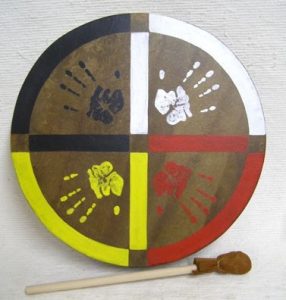The Wheel and the Americas: A Look at the Absence of the Wheel in Native American Cultures
The Wheel and the Americas: A Look at the Absence of the Wheel in Native American Cultures

The wheel, a seemingly simple invention, revolutionized transportation and technology across the globe. Yet, in the vast expanse of the Americas, it remained absent until the arrival of Europeans. This absence, often cited as a marker of "backwardness," has puzzled historians and anthropologists for centuries. However, a deeper examination reveals a complex interplay of factors, challenging simplistic narratives and highlighting the ingenuity of Native American cultures.
The Myth of the "Missing" Wheel:
Related Articles: The Wheel and the Americas: A Look at the Absence of the Wheel in Native American Cultures
- Hopping Into Art: Exploring The World Of Kangaroo Artwork
- Beyond The Bush: Finding The Perfect Cool Aboriginal Boy’s Name
- The Green Guardians: Choosing Non-Invasive Trees For Your Australian Garden
- Walking In The Footsteps Of The Ancestors: Connecting With Land, Dreamtime, And Aboriginal Spirituality
- The Aboriginal Flag: A Tapestry Of Colors, A Symphony Of Meaning
The absence of the wheel in the Americas is frequently presented as a puzzle, a missed opportunity in the development of Native American societies. This perspective often implies that Native Americans were somehow intellectually inferior, unable to grasp the concept or create the technology. However, this narrative fails to acknowledge the diverse and sophisticated cultures that existed across the Americas, each with its own unique adaptations to its environment.
Environmental Factors and Alternative Technologies:
The absence of the wheel in the Americas can be partly attributed to the unique environmental conditions. The vast majority of North and South America lacked the necessary resources for the development of wheeled transportation:
- Lack of Suitable Draft Animals: The wheel is most effective when used in conjunction with draft animals like horses or oxen. These animals were absent from the Americas until their introduction by Europeans.
- Terrain and Climate: Much of the Americas, particularly in the central and northern regions, featured challenging terrain, including mountains, dense forests, and swamps. These environments were not conducive to the use of wheeled vehicles.
- Availability of Water Transportation: Many Native American cultures lived near rivers, lakes, and coastlines, making water transportation a more efficient and practical mode of travel. Canoes and rafts, crafted from wood and animal hides, served as crucial transportation tools.

The Importance of Context:
It is crucial to understand that the wheel was not a universal invention. Many ancient civilizations, like the Maya and the Inca, developed complex societies and technologies without the use of wheels. Their innovations, such as the construction of elaborate pyramids, intricate irrigation systems, and sophisticated textiles, demonstrate their ingenuity and adaptability.
Alternative Modes of Transportation:
Native Americans developed a range of transportation methods that were uniquely suited to their environments:
- Carrying and Travois: Instead of wheels, Native Americans used carrying poles, slings, and travois (a frame pulled by dogs or horses) to transport goods and supplies.
- Pack Animals: In some regions, llamas and alpacas were domesticated for carrying loads.
- Foot Travel: For shorter distances, walking remained the primary mode of transportation.
- Canoes and Rafts: As mentioned earlier, water transportation was crucial for many Native American cultures.


The Arrival of the Wheel:
When Europeans arrived in the Americas, they brought with them the wheel and its associated technologies. The introduction of the wheel had a profound impact on Native American societies, facilitating trade, warfare, and exploration. However, the wheel’s adoption was not without its challenges. It often disrupted traditional ways of life and led to the displacement of indigenous populations.
The Significance of the "Missing" Wheel:
While the absence of the wheel in the Americas may seem like a missed opportunity, it is essential to consider the broader context. Native American cultures developed unique and effective solutions to their transportation needs, demonstrating their resilience and adaptability. Their absence of the wheel should not be interpreted as a sign of backwardness, but rather as a testament to the diverse and innovative nature of human ingenuity.
The Legacy of Native American Innovation:
The story of the "missing" wheel in the Americas is not simply about a technological gap. It is a reminder of the importance of understanding the context and complexity of different cultures. It challenges us to move beyond simplistic narratives and appreciate the diverse forms of knowledge and ingenuity that have shaped the human experience.
FAQs:
1. Why didn’t Native Americans develop the wheel?
There are several factors that contributed to the absence of the wheel in the Americas, including the lack of suitable draft animals, challenging terrain, and the availability of alternative transportation methods like canoes and pack animals.
2. Were Native Americans less intelligent than other civilizations?
Absolutely not. Native American cultures developed complex societies, sophisticated technologies, and unique adaptations to their environments. The absence of the wheel does not indicate a lack of intelligence, but rather reflects the specific challenges and opportunities they faced.
3. Did Native Americans ever use the wheel?
Native Americans did not develop the wheel independently. However, after European contact, they began to adopt and adapt wheeled technologies.
4. What impact did the introduction of the wheel have on Native American societies?
The introduction of the wheel had a significant impact on Native American societies, both positive and negative. It facilitated trade, warfare, and exploration, but it also disrupted traditional ways of life and led to the displacement of indigenous populations.
5. What other technologies did Native Americans develop?
Native American cultures developed a wide range of innovative technologies, including:
- Agriculture: They cultivated a variety of crops, including corn, beans, and squash.
- Architecture: They built impressive structures, such as pyramids, mounds, and cliff dwellings.
- Textiles: They wove intricate fabrics from cotton, wool, and other materials.
- Astronomy: They developed sophisticated systems for tracking the stars and planets.
- Medicine: They used a wide range of plants and herbs for medicinal purposes.
Conclusion:
The absence of the wheel in the Americas is a complex story, one that defies simplistic explanations. By understanding the environmental factors, alternative technologies, and the broader context of Native American cultures, we can gain a deeper appreciation for their ingenuity and adaptability. The "missing" wheel serves as a reminder of the diverse and fascinating ways in which human societies have interacted with their environments and developed unique solutions to their challenges.

Closure
Thus, we hope this article has provided valuable insights into The Wheel and the Americas: A Look at the Absence of the Wheel in Native American Cultures. We hope you find this article informative and beneficial. See you in our next article!